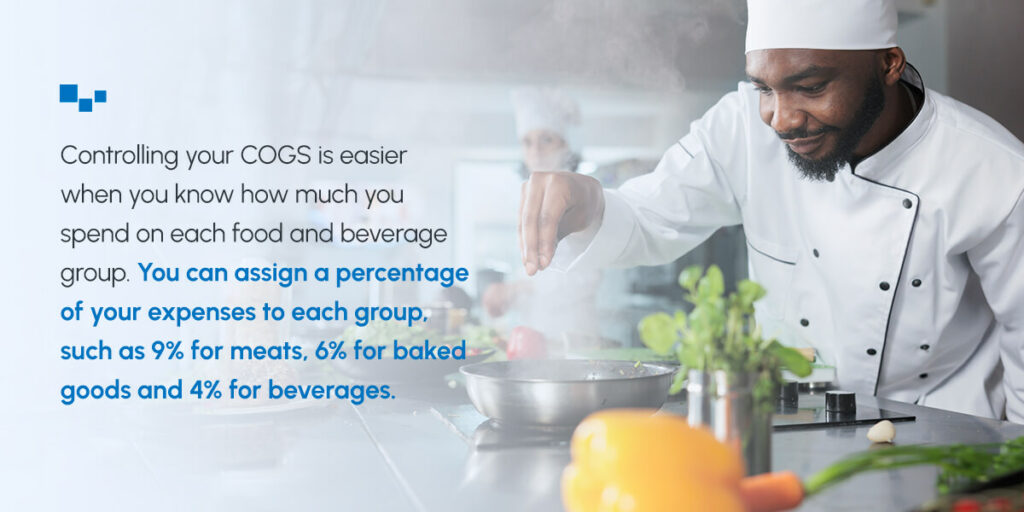

Your cost of goods sold — or COGS — accounts for a large amount of your food service business’s overall expenses. Managing COGS for restaurants correctly can boost your profitability and cash flow, and it’s critical to the financial health of your business.
Knowing how to reduce the COGS in your restaurant is essential for smooth and profitable operations. Yet, many business owners need to pay more attention to managing COGS. You can see significant results with these simple tips to reduce your COGS.
In a restaurant or catering business, COGS is the amount of money your company spends on supplies and ingredients. These could include beverages, meat, fruits, seasoning and vegetables — anything you need to prepare items on the menu. A good cost of goods sold percentage is no more than 31% of your sales. Knowing how to reduce COGS in your restaurant has significant benefits, including cutting expenses and increasing profits.
To calculate COGS for restaurants, you can use the following formula:
You can break down this formula into easily digestible chunks, including the following.
The final number provides essential information about your income on the food and beverages you sell.
Knowing how to lower COGS in your restaurant can help drive success. Ideally, you have a target COGS for your organization, and the goal is to match your actual COGS with that target. Discrepancies in your COGS can impact your gross profit. Some of the methods you can use to lower your COGS include the following:

Controlling your COGS is easier when you know how much you spend on each food and beverage group. You can assign a percentage of your expenses to each group, such as 9% for meats, 6% for baked goods and 4% for beverages. With this method, you can ensure you stay within your target COGS percentage.
You can calculate the cost of your recipes and break down your food and beverage into groups that suit your operation as long as you have set parameters for spending in each category.
Strong, lasting relationships with suppliers are important to many food and beverage business owners. However, staying abreast of cost-effective, quality alternatives is a sound policy. Keep your eye out for suppliers that can save you money, provided the pricing doesn’t affect the quality of the food you provide your customers.
Sometimes, it’s the small details that eat into your profits. If your prep workers have no protocols to measure ingredients, the small mismeasurements can add up to big dents in your profit. For example, if a recipe calls for a cup of cheese and your prep workers consistently use two cups, the cost of your cheese doubles.
Enforce strict guidelines for recipe measurement and ensure all your employees are aware of them.
As the seasons change, the price and availability of certain ingredients change. The price of fresh produce like fruits and vegetables increases and decreases due to seasonal availability. You can lower your COGS by incorporating seasonal items when they are in-season and available at lower prices. If you want off-season items on your menu, ensure you adjust the price of these items to reflect the higher purchase cost.
Think beyond the more prominent ingredients and create ways to tweak your dishes with seasonal herbs and spices or market your seasonal changes to incorporate fresh, local produce and keep your customers interested.
Many restaurants avoid stock shortages by ordering additional stock before the current inventory is depleted. Rotating these items to ensure you use the previously purchased items first is essential so they don’t spoil and lead to wastage. Label and date all your food items and put new shipments behind your current ones in your dry stock and refrigeration areas, so your staff will reach for them automatically when needed.
Your inventory can only make you money if you store your food goods correctly. Store your produce at the correct temperatures and take regular inventory to avoid unnecessary storage costs and extra storage that result in food spoiling.
Specials are a fantastic way to reduce waste in your kitchen. You can put foods close to their expiry date on sale or offer a promotion to encourage customers to buy them, thus reducing the waste of unused stock in your kitchen.
Large portions lead to waste. If your patrons can’t finish the food you serve them, their wasted leftovers accumulate and cost you money. Calculate your portion sizes accurately and monitor unfinished items so you can make the necessary changes.
Ingredient prices constantly change — failing to account for this in your costs could result in a lack of optimization in your COGS. Keep your calculations up to date and change your prices when necessary.
Managing your storage is essential for lowering your COGS, but restaurant owners often overlook deliveries, assuming the weights and amounts delivered are correct. Ensure your goods are delivered correctly by checking the weights, prices and quantities upon delivery and correcting any discrepancies.
Pay attention to your menu to lower COGS and give customers what they like most. Take note of items that sell well and cut things that don’t. Be ruthless if you have to. Extensive menus make it more challenging to maintain quality and can raise your COGS by increasing the inventory you need, especially when it comes to fresh items that spoil quickly.
Your point of sale (POS) and restaurant management systems should be an asset to your business. An all-in-one solution for inventory management, purchases and sales can help lower costs and boost your profits. Consider whether you’re using the best software for your needs, and if not, look at switching to a restaurant management software provider that can.
Lowering your COGS is critical to boosting your profits and minimizing wastage in your restaurant or catering business. With Recipe Costing, you can calculate menu costs accurately and analyze your COGS to streamline your operations and boost your profits. Recipe Costing is a powerful complete restaurant management software created by operators in the food service business who understand industry requirements and how vital it is to maintain a competitive edge.
Take the guesswork out of lowering your COGS and know your efforts are profitable with Recipe Costing. Book a demo today to see how to reduce unnecessary costs and focus on what you do best — keeping your customers coming back for more!